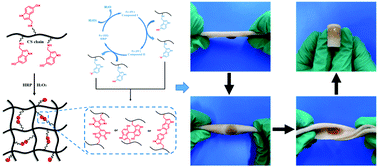An injectable serotonin–chondroitin sulfate hydrogel for bio-inspired hemostatic adhesives with high wound healing capability†
Abstract
Biocompatibility, hemostatic performance and wound healing capability are key limitations for the currently available hemostatic agents. To overcome these problems, a hydrogel inspired by a platelet coagulation mediator is developed in this work as a new class of hemostatic adhesive with improved performance and wound healing capability. The hydrogel is prepared using highly biocompatible serotonin and chondroitin sulfate (CS), both of which are natural components of the body. The structural, physical and biological and hemostatic properties of the hydrogel are characterized in detail. It is demonstrated that serotonin acts as a crosslinker to form adhesive hydrogels and as a blood clotting mediator for rapid hemostasis. Chondroitin sulfate regulates cell behaviors and fates to facilitate wound healing. The serotonin-conjugated chondroitin sulfate hydrogel exhibits improved hemostatic capability in vivo and rapid wound healing after hemostasis. In addition, the wound healing capability of the hydrogel is further improved with the aloe vera powder, confirming the versatility of the hydrogel system. Therefore, chondroitin sulfate–serotonin hydrogels exhibit the potential for effective hemostasis and wound healing.



 Please wait while we load your content...
Please wait while we load your content...